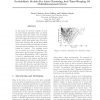Free Online Productivity Tools
i2Speak
i2Symbol
i2OCR
iTex2Img
iWeb2Print
iWeb2Shot
i2Type
iPdf2Split
iPdf2Merge
i2Bopomofo
i2Arabic
i2Style
i2Image
i2PDF
iLatex2Rtf
Sci2ools
UAI
2003
2003
Probabilistic Models For Joint Clustering And Time-Warping Of Multidimensional Curves
In this paper we present a family of models and learning algorithms that can simultaneously align and cluster sets of multidimensional curves measured on a discrete time grid. Our approach is based on a generative mixture model that allows both local nonlinear time warping and global linear shifts of the observed curves in both time and measurement spaces relative to the mean curves within the clusters. The resulting model can be viewed as a form of Bayesian network with a special temporal structure. The Expectation-Maximization (EM) algorithm is used to simultaneously recover both the curve models for each cluster, and the most likely alignments and cluster membership for each curve. We evaluate the methodology on two real-world data sets, and show that the Bayesian network models provide systematic improvements in predictive power over more conventional clustering approaches.
| Added | 01 Nov 2010 |
| Updated | 01 Nov 2010 |
| Type | Conference |
| Year | 2003 |
| Where | UAI |
| Authors | Darya Chudova, Scott Gaffney, Padhraic Smyth |
Comments (0)

